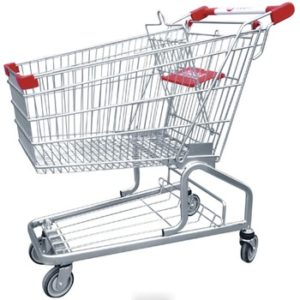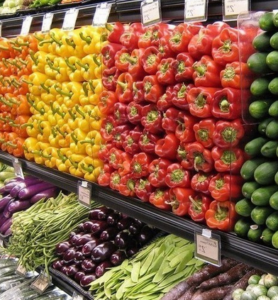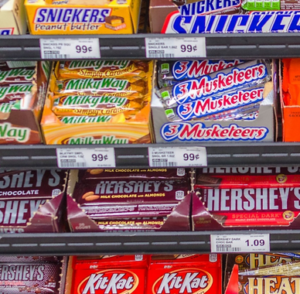How many times have you gone to the supermarket to pick up a just few items like milk & eggs but end up with a cart full of items?
Supermarkets like any other business spend lots of time and money figuring out ways to get shoppers to buy more. These strategies include classic marketing methods as well as psychological techniques that go unnoticed by most shoppers. Everything from what you see, smell and hear in a supermarket has a specific purpose of making you shop more.
The Shopping Cart
Upon entering a store, a shopper is showered with hundreds of messages. A supermarket’s first goal is to make sure you take a shopping cart.  How do they make you take a cart you ask? Stores will put items that are too difficult to carry on sale at the entrance of the store. It can be watermelons, a pack of water bottles or large laundry detergents. Their hope is that once you see that great sale on those items, you’ll want to buy it and thus force you take a shopping cart even if you had no intention to. Once you have a shopping cart, you’ll automatically shop more. Furthermore, is it just me or has shopping carts gotten larger and larger while shopping baskets are almost becoming extinct? That’s done on purpose too. Stores don’t want your shopping limited by the size of your basket. The larger your cart, the more likely you’ll spend more.
How do they make you take a cart you ask? Stores will put items that are too difficult to carry on sale at the entrance of the store. It can be watermelons, a pack of water bottles or large laundry detergents. Their hope is that once you see that great sale on those items, you’ll want to buy it and thus force you take a shopping cart even if you had no intention to. Once you have a shopping cart, you’ll automatically shop more. Furthermore, is it just me or has shopping carts gotten larger and larger while shopping baskets are almost becoming extinct? That’s done on purpose too. Stores don’t want your shopping limited by the size of your basket. The larger your cart, the more likely you’ll spend more.
No Escape
Once you enter a supermarket, its not easy getting out without purchasing something. Stores are generally built with a one way entry door and a separate one way door to exit. The exit is usually only accessible by going through the checkout line or by going through a majority of the store.
Music in the Background
Ever wonder why stores have music running in the background as opposed to the news, sports or talk shows? Music tends to naturally put people in a jovial mood. People in good moods or a happy environment will stick around longer, and thus will spend more time (and money) shopping.
Produce Department
The produce department is always at the front of the store. That’s because it has a wide array of bright colors, scents and textures that sets a tone of freshness and puts you in a good mood. Like we mentioned before with the music, being in a good mood will encourage you to explore the rest of the store. Some stores take it to the next level by having a vast array of flowers for sale as you enter the store. Just imagine how different your shopping experience would be if upon entering the store, you instead see canned foods or paper products.
 Furthermore, ever wonder why the plastic bags for the produce are really large? And by large, I mean extra extra large. That’s because the bigger the bag, the more empty it feels when you start filling it up. If you put just 3 apples or tomatoes in a bag, it gives you a feeling as if you barely got any since there’s so much room in the bag, thus encouraging you to add to it.
Furthermore, ever wonder why the plastic bags for the produce are really large? And by large, I mean extra extra large. That’s because the bigger the bag, the more empty it feels when you start filling it up. If you put just 3 apples or tomatoes in a bag, it gives you a feeling as if you barely got any since there’s so much room in the bag, thus encouraging you to add to it.
Stores occasionally spray this mist on various fruits and vegetables in the produce department. That’s done to make the produce look more fresh, especially when there’s light shined on it. It makes the apples glow, the leafy vegetables so fresh and the tomatoes so succulent. But be weary, the extended time the mist is on the produce will cause it to rot faster so wipe it off as soon as you get home.
Another reason supermarkets start off with the produce department is to give shoppers a gratifying feeling of adding healthy items to their cart which will more likely lead to them buying junk food as a ‘self-reward.’
The Milk in the Back
The consensus is that grocery stores keep the milk, eggs and other daily essentials in the back of the store to force you to pass by thousands of products you wouldn’t otherwise see. While this is definitely true, there is an alternate reason why its in the back. Milk has to be kept cold at all times. Vendors and Supermarkets have to work together to minimize the amount of time the milk is out of the refrigerator. Therefore, stores that have their coolers and loading docks in the back have a legitimate reason to have their milk there. Otherwise, the stores want you making the rounds past all the shelves and displays until you get to the milk and then walk past all those products again when leaving.
Same philosophy is applied by pharmacies as well. Its no mystery why they have you walk past the entire pharmacy to fill your prescription.
Product Placement
Every product on every shelf is strategically placed by the store. Next time you’re at the cereal aisle, take note of its layout. The cereals with the colorful packaging are on the lower shelves, while the cereals that are more health oriented are toward the top. The reason for this is that the cereal on the bottom is purposely placed at a child’s eye level. The end game here is the child manipulating their parents to purchase the cereal they had no intention of buying. Stores know very well how successful a child’s cry or whine in public is to get their parents to purchase the treats they see.
Same psychology goes for every other aisle. The most expensive or highly profitable items will always be at eye level while the generic or less profitable items will be buried somewhere low or really high. In a similar sense, the most popular items or brands that are within the aisles will always be at the aisle’s midpoint forcing shoppers to walk past some more products.
Prime locations for products retailers want to push are the ‘End caps’ or the End of Aisle Displays. Just about every shopper will pass these end caps on their way to the milk which is why these end aisles are sometimes ‘sold’ to vendors to display their products. Another purpose for these end caps is to get people in the aisle. By putting an intriguing sale item at the end of aisle display, the hope is that it would give a shopper enough of a reason to see what else is in that aisle.
Checkout
The checkout line is always at the front of the store. That’s not because of convenience as much as it is to force you to circle back around the entire store to return to the front to pay. Increasing the likelihood a product or display will catch your attention on the way back.
Moreover, have you realized how there’s barely any room around the registers today? That’s because stores don’t want you to have room to off-load products as you checkout making it harder for you to ditch products at the last minute.
Also, there always seems to be a line at the register. Many times, that’s done purposely because the longer you’re on line, the more of a chance you’ll make…..
Impulse Buys
One of the most profitable areas of a store in terms of markup is the checkout line. This is where stores want you to succumb to the temptation of those candy bars or ice cold soft drinks. The longer you’re waiting on line, the more time the candy rack has to entice you. In addition, stores  know that psychologically speaking, when you’re about to swipe for a $250 grocery bill, that candy bar doesn’t seem that expensive. You’ll think to yourself “I’m already paying $250, what’s another $5.” This is why it’s one of the most profitable areas for a supermarket as these items are usually marked up by more than 200%.
know that psychologically speaking, when you’re about to swipe for a $250 grocery bill, that candy bar doesn’t seem that expensive. You’ll think to yourself “I’m already paying $250, what’s another $5.” This is why it’s one of the most profitable areas for a supermarket as these items are usually marked up by more than 200%.
Other Tricks
All stores price products with a .99 as opposed to a round number. When an item is priced at lets say $4.99, we tend to think of it as costing $4 as opposed to $5.
Additionally, many stores purposely change the placement of many common items or completely remodel some aisles because if you don’t know where the items are, you’ll spend more time in the store looking for it. Again, the more time they get you to stay in the store, the more likely you’re going to buy more things.
Conclusion
The average person makes 75 trips to a supermarket in a year and just about every single time, you’ll spend more than you had hoped for when you first entered. Retailers hire consultants as independent contractors for strategies to keep shoppers in stores for as long as possible. Now knowing the above, many shoppers can tackle this in their own way. Our advice would be to (a) make a list and stick to it (b) keep the kids at home if possible and (c) maybe most importantly, never shop when you’re hungry.
Stay Connected!
Follow @TJBDeals On Twitter
Like On Facebook!
@TJBDeals on Instagram
Join Our Whatsapp Group!
Get Alerts via SMS by Texting ‘Follow TJBDeals‘ to 40404
Join Our Telegram Channel!
